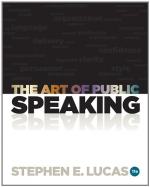In a preliminary way, notice how radically the public speaker’s use of narrative differs from that of the story-writer in the more limited scope, absence of extended dialogue and character drawing, and freedom from elaboration of detail, which characterize platform narrative. On the other hand, there are several similarities of method: the frequent combination of narration with exposition, description, argumentation, and pleading; the care exercised in the arrangement of material so as to produce a strong effect at the close (climax); the very general practise of concealing the “point” (denouement) of a story until the effective moment; and the careful suppression of needless, and therefore hurtful, details.
So we see that, whether for magazine or platform, the art of narration involves far more than the recital of annals; the succession of events recorded requires a plan in order to bring them out with real effect.
It will be noticed, too, that the literary style in platform narration is likely to be either less polished and more vigorously dramatic than in that intended for publication, or else more fervid and elevated in tone. In this latter respect, however, the best platform speaking of today differs from the models of the preceding generation, wherein a highly dignified, and sometimes pompous, style was thought the only fitting dress for a public deliverance. Great, noble and stirring as these older masters were in their lofty and impassioned eloquence, we are sometimes oppressed when we read their sounding periods for any great length of time—even allowing for all that we lose by missing the speaker’s presence, voice, and fire. So let us model our platform narration, as our other forms of speech, upon the effective addresses of the moderns, without lessening our admiration for the older school.
The Anecdote
An anecdote is a short narrative of a single event, told as being striking enough to bring out a point. The keener the point, the more condensed the form, and the more suddenly the application strikes the hearer, the better the story.
To regard an anecdote as an illustration—an interpretive picture—will help to hold us to its true purpose, for a purposeless story is of all offenses on the platform the most asinine. A perfectly capital joke will fall flat when it is dragged in by the nape without evident bearing on the subject under discussion. On the other hand, an apposite anecdote has saved many a speech from failure.
“There is no finer opportunity for the display of tact than in the introduction of witty or humorous stories into a discourse. Wit is keen and like a rapier, piercing deeply, sometimes even to the heart. Humor is good-natured, and does not wound. Wit is founded upon the sudden discovery of an unsuspected relation existing between two ideas. Humor deals with things out of relation—with the incongruous. It was wit in Douglass Jerrold to retort upon the scowl of a stranger whose shoulder he had familiarly slapped, mistaking him for a friend: ’I beg your pardon, I thought I knew you—but I’m glad I don’t.’ It was humor in the Southern orator, John Wise, to liken the pleasure of spending an evening with a Puritan girl to that of sitting on a block of ice in winter, cracking hailstones between his teeth."[24]




